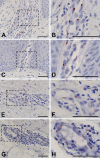Aberrant expression of histo-blood group A type 3 antigens in vascular endothelial cells in inflammatory sites
- PMID: 17998569
- PMCID: PMC2324182
- DOI: 10.1369/jhc.7A7290.2007
Aberrant expression of histo-blood group A type 3 antigens in vascular endothelial cells in inflammatory sites
Abstract
Histo-blood group ABH antigens are widely distributed in human tissues. The epitopes of ABH antigens are carried by at least four different peripheral core isotypes of internal carbohydrate backbones (type 1-4). Each type of ABH antigen is expressed tissue specifically, and aberrant expression of ABH antigens is often observed during oncogenesis. We immunohistochemically examined the expression of A type 3 antigens in wounded and diseased skin tissues (A and AB blood groups). In uninjured skin, the expression of A type 3 antigens was restricted to the eccrine sweat gland. In addition to the sweat glands, A type 3 antigens were found in vascular endothelial cells of the wound sites. The extent of A type 3 antigens expression related to postinfliction intervals. A significantly higher expression rate of A type 3 antigens in endothelial cells was also observed in diseased skin, suggesting that inflammation might induce A type 3 antigen expression in endothelial cells. Double-color immunofluorescence staining of the specimens showed that von Willebrand factor (vWF) was a core-protein of A type 3 determinants aberrantly expressed in endothelial cells in inflamed tissues, suggesting that aberrant expression of A type 3 antigens is involved in stabilization of vWF in inflammation.
Figures





Similar articles
-
Dissociation of ABH antigen expression from von Willebrand factor synthesis in endothelial cell lines.Br J Haematol. 2003 Jun;121(6):928-31. doi: 10.1046/j.1365-2141.2003.04366.x. Br J Haematol. 2003. PMID: 12786805
-
ABH and related histo-blood group antigens in normal & malignant human endometrium in relation to genetic and hormonal factors.APMIS Suppl. 1997;69:1-33. APMIS Suppl. 1997. PMID: 9254838
-
ABO blood antigens define human cerebral endothelial diversity.Neuroreport. 2013 Jan 23;24(2):79-83. doi: 10.1097/WNR.0b013e32835c93a2. Neuroreport. 2013. PMID: 23262469
-
ABH and related histo-blood group antigens; immunochemical differences in carrier isotypes and their distribution.Vox Sang. 1989;56(1):1-20. doi: 10.1111/j.1423-0410.1989.tb03040.x. Vox Sang. 1989. PMID: 2464874 Review.
-
The relationship between ABO histo-blood group, factor VIII and von Willebrand factor.Transfus Med. 2001 Aug;11(4):343-51. doi: 10.1046/j.1365-3148.2001.00315.x. Transfus Med. 2001. PMID: 11532189 Review.
Cited by
-
Aging and ABO blood type influence von Willebrand factor and factor VIII levels through interrelated mechanisms.J Thromb Haemost. 2016 May;14(5):953-63. doi: 10.1111/jth.13294. Epub 2016 Apr 27. J Thromb Haemost. 2016. PMID: 26875505 Free PMC article.
-
Expression of histo-blood group A type 1, 2 and 3 antigens in normal skin and extramammary Paget's disease.Acta Histochem Cytochem. 2008 Dec 27;41(6):165-71. doi: 10.1267/ahc.08021. Epub 2008 Oct 30. Acta Histochem Cytochem. 2008. PMID: 19180201 Free PMC article.
-
Evaluation of endothelial microparticles as a prognostic marker in hemolytic disease of the newborn in China.J Int Med Res. 2019 Nov;47(11):5732-5739. doi: 10.1177/0300060519870947. Epub 2019 Sep 13. J Int Med Res. 2019. PMID: 31516072 Free PMC article.
-
Emergence of an erythroid cell-specific regulatory region in ABO intron 1 attributable to A- or B-antigen expression on erythrocytes in Hominoidea.Sci Rep. 2023 Mar 27;13(1):4947. doi: 10.1038/s41598-023-31961-6. Sci Rep. 2023. PMID: 36973299 Free PMC article.
-
CD144+ endothelial microparticles as a marker of endothelial injury in neonatal ABO blood group incompatibility.Blood Transfus. 2014 Apr;12(2):250-9. doi: 10.2450/2013.0101-13. Epub 2013 Nov 15. Blood Transfus. 2014. PMID: 24333075 Free PMC article.
References
-
- Adobati E, Panza L, Russo G, Colnaghi MI, Canevari S (1997) In vitro mimicry of CaMBr1 tumor-associated antigen by synthetic oligosaccharides. Glycobiology 7:173–178 - PubMed
-
- Bernardo A, Ball C, Nolasco L, Moake JF, Dong JF (2004) Effects of inflammatory cytokines on the release and cleavage of the endothelial cell-derived ultralarge von Willebrand factor multimers under flow. Blood 104:100–106 - PubMed
-
- Bonifati C, Carducci M, Mussi A, D'auria L, Ameglio F (1997) IL-1 α, IL-1β and psoriasis: conflicting results in the literature. Opposite behaviour of the two cytokines in lesional or non-lesional extracts of whole skin. J Biol Regul Homeost Agents 11:133–136 - PubMed
-
- Bowen DJ (2003) An influence of ABO blood group on the rate of proteolysis of von Willebrand factor by ADAMTS13. J Thromb Haemost 1:33–40 - PubMed
-
- Bremer EG, Levery SB, Sonnino S, Ghidoni R, Canevari S, Kannagi R, Hakomori S (1984) Characterization of a glycosphingolipid antigen defined by the monoclonal antibody MBr1 expressed in normal and neoplastic epithelial cells of human mammary gland. J Biol Chem 259:14773–14777 - PubMed
MeSH terms
Substances
LinkOut - more resources
Full Text Sources
Other Literature Sources
Medical
Miscellaneous

